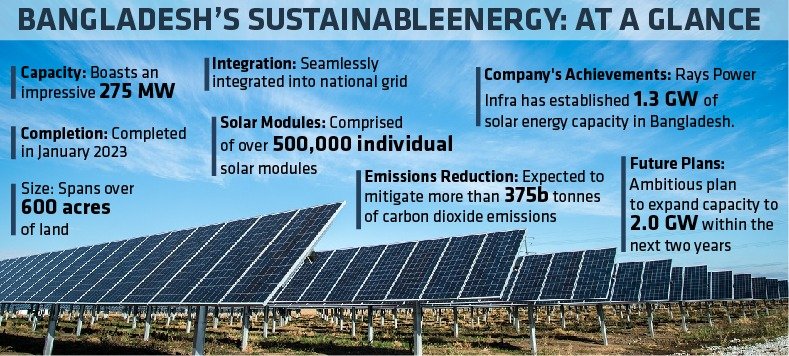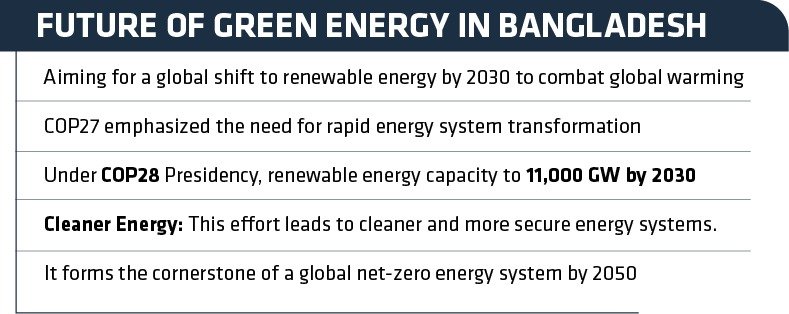Electricity Generation Company of Bangladesh (EGCB) has reached the advanced stages of constructing a solar power plant in Sonagazi, Feni, initially planned for a 50MW capacity but subsequently upgraded to produce 100MW of power
Bangladesh’s energy sector is undergoing a rapid transformation, driven by a renewed emphasis on renewable energy sources to combat the challenges posed by climate change and environmental pollution. Within this context, the Barapukuria Solar Power Plant represents a significant commitment to sustainable energy production.
In a pioneering initiative, the Electricity Generation Company of Bangladesh Limited (EGCB) has plans to construct an additional 100MW solar power plant in the Sonagazi upazila of Feni.
To achieve this, EGCB will establish a joint venture in partnership with the Japanese company Marubeni.
You can also read: Barapukuria Solar Power Plant: Illuminating Bangladesh’s Green Energy Revolution
Sources within the power division indicate that the agreement to form this joint venture between Marubeni and EGCB is on the verge of being finalized.
Notably, EGCB is already in the advanced stages of building a solar power plant in Sonagazi, Feni. Originally designed for a 50MW capacity, it has since been upgraded to generate 100MW of power.
Commercial production at this facility is anticipated to commence in either October or November, as per EGCB insiders.
Why choose Feni coastline?
Sonagazi is located on the coast, it offers opportunities for the development of both solar and wind power facilities.
An official from EGCB emphasized the significant amount of uncultivated land available along the Feni coast, making it an ideal choice for constructing solar power plants. These lands often lie unused for various seasons due to natural disasters such as storms and floods, which makes them excellent locations for solar power projects.
However, building solar power plants in coastal areas like this brings about challenges related to tides and wind. To address these concerns, experts have meticulously designed the infrastructure in Sonagazi, ensuring that solar panels can withstand wind gusts of up to 280km/hr. Additionally, the plant has been equipped with protective fencing and drainage systems to mitigate the impact of storms, tides, and the potential for waterlogging.
Increasing solar power production
According to insiders at the ministry, the government is eager to accelerate the expansion of solar power generation.
To achieve this goal, active endeavors are underway to establish the plant through partnerships with several foreign firms. This approach enhances the potential for foreign investments, which can play a pivotal role in alleviating the country’s currency-related challenges.
Notably, the Japanese company Marubini is involved in diverse sectors beyond energy and infrastructure. In addition to solar power ventures, the company is also engaged in the construction of wind power facilities.
Largest Solar Power Plant’s in Bangladesh
The Rays Power Infra solar plant in Sundarganj, Gaibandha, boasting a substantial 275-MW capacity, now stands as Bangladesh’s largest solar photovoltaic power facility. This impressive project reached completion in January 2023 and is seamlessly integrated into the national grid. Spanning an expansive 600 acres of land, the plant is comprised of over 500,000 individual solar modules. Projections indicate that over its operational lifespan, this facility will play a vital role in mitigating more than 375 billion tonnes of carbon dioxide emissions.
Rays Power Infra has already established a significant 1.3 GW of solar energy capacity within the country. Their strategic vision for the future includes an ambitious plan to further expand this capacity to 2.0 GW within the next two years.

Bangladesh’s clean energy journey, ongoing projects
Since 1996, Bangladesh has successfully deployed over six million Solar Home System (SHS) units, in addition to thousands of rooftop installations, solar-powered street lighting, telecom BTS, and solar irrigation systems.
These active government initiatives have paved the way for a gradual transition towards renewable energy sources. It is anticipated that solar energy’s share in the energy mix will experience rapid growth in the coming years. This project is expected to play a pivotal role in facilitating regional economic development.
Bangladesh is poised to join the ranks of China, India, and the UAE in the “gigawatt club” by embarking on the implementation of more than a dozen large-scale solar power plants, including three with a staggering capacity of 1,000MW each. Notably, one of these three mega-plants is under construction on Swarna Dwip (formerly Jahazzair Char) in Noakhali. In February of the previous year, Pacific Energy Group, LLC (Pacific Energy), based in the United States, and its Hong Kong subsidiary, Eleris Energy Limited, signed a Joint Venture Agreement (JVA) with the Bangladesh Army Welfare Trust to oversee the construction of this particular plant.
In 2017, Bangladesh initiated the construction of an extensive solar facility featuring approximately five million solar panels. Stretching from Teesta Ghat in Sundarganj to Rangpur, a 132-kilovolt, 35-kilometer-long power transmission line was erected to connect the generated electricity to the national grid. Additionally, substations, equipment, and inverters were installed to ensure the efficient functioning of the facility.
This remarkable 200 MW solar plant surpasses the 134.3 MW plant in Mongla, which is owned by Energon Renewables Ltd, a subsidiary of the Orion Group.
COP28, the Future of Green Energy in Bangladesh

The Barapukuria Solar Power Plant represents a significant step in Bangladesh’s transition to renewable energy sources. The government’s commitment to achieving higher percentages of electricity from renewables and the involvement of international players like Sumitomo Corporation are positive signs for a more sustainable and environmentally friendly energy future for the country.
Setting a worldwide objective for 2030 sends a distinct message to governments, industries, investors, and civil society, accenting the pressing requirement to significantly quicken the adoption of renewable energy sources in the coming seven years. This acceleration is crucial to restrict global warming to a 1.5°C pathway, a recognition underscored during COP27 last year, emphasizing the imperative of rapidly transforming energy systems in this critical decade of action.
Under the leadership of the COP28 Presidency, policymakers, and heads of international energy agencies, discussions are already underway to unite behind a shared objective: tripling the global renewable energy capacity to a minimum of 11,000 GW by 2030. This ambitious goal entails expediting the expansion of wind, solar, hydropower, and geothermal energy, laying the groundwork for technologies. This collective effort not only ensures cleaner energy systems but also enhances their security, forming the cornerstone of a global net-zero energy system by 2050.
With a strong focus on solar power, wind energy potential, and harnessing its river resources, Bangladesh is poised to showcase its commitment to a greener future at COP28.


